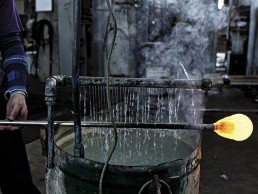
Lead Crystal, Italy
Terzani’s relationship with lead crystal has been one of love and the art of perfection. Creative Director and President of Terzani Nicolas Terzani tells darc how he fell for its dance with light.
Closely connected to Terzani’s home in Tuscany, Italy, the hills between Florence and Siena produce 15% of the world’s lead crystal. Terzani works to ensure the beauty of this local material lives on by interpreting it in the company’s own unique way. “Lead crystal is the perfect material to recreate organic shapes,” Creative Director Nicolas Terzani tells darc.
Lead crystal involves the addition of lead oxide to normal glass, which raises its refractive index and lowers its working temperature and viscosity. The beauty of lead crystal relies on the high refractive index caused by the increase in lead content.
From the glassmaker’s perspective, this results in two practical developments; lead glass can be worked at a lower temperature, and clear vessels can be made free from trapped air bubbles with less difficulty than normal glass, allowing the manufacturer to create perfectly clear objects. When trapped, lead crystal makes a ringing sound, unlike ordinary glass, a trick of the trade that consumers still rely on to distinguish it from cheaper glass. Boiling down the science of lead crystal in the making shows the organic nature of the beautiful material and how it can be worked easily by expert hands. “The result is much more similiar to water that has been stopped in its tracks than it is to glass,” says Terzani.
The Italian lighting manufacturer has worked on several product ranges using lead crystal including Mizu and Sharpei, however the discovery of this material that has led to so many unique creations was made entirely by chance. Mizu designed by Terzani’s Creative Director is a pendant inspired by the tranquil and mesmerising light refractions created by water. “When I did the first prototype, I had no idea,” he tells darc. “I went to our suppliers at the crystal factory who have a lot of experience with this material. I started experimenting and when we put the light inside the Mizu and saw the effect that it made, it was totally unexpected. It turned out to be the greatest feature of the product, and such a nice moment because it happened by chance.” Like waterdroplets, no two Mizu are alike with each crystal shape made by hand using 24% lead crystal.
Having worked extensively with glass, Terzani was aware of how Mizu would appear to have a grey or greenish tint because of the amount of glass that would have been needed for the product. So when he saw the lead crystal, he realised, “it’s just the perfect material to do this. It looks like a drop of water.” From there, Terzani saw that crystal could be used in different designs such as the Shar Pei pendants to further show off these qualities. Shar Pei employs sheaths of wrinkled crystal that take their cues from Shar Pei puppies. These pendants display an elegant projection of light, again through undulating 24% lead crystal. With its only challenge being its weight, as lead crystal is heavier than regular glass, the refraction properties and clarity of lead crystal prevail.
In a reflection of Terzani’s values as a company, lead crystal highlights elegance and displays the same attention to detail seen in Terzani’s production and in the work of its Creative Director. The company uses this material to create a timeless elegance, entirely reflecting the principles of value and perfection that Terzani consistently upholds.
www.terzani.com



